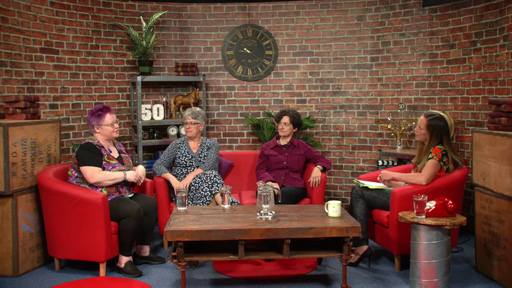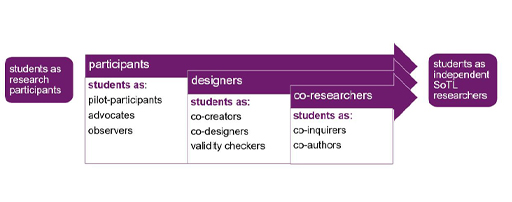1.1 Involving students as partners in SoTL
These are various ways to involve students as partners in a SoTL inquiry (Figure 1):
- pilot participants: students act as pilot participants to trial research materials such as questionnaires and interview protocols, then give feedback ahead of the implementation of research materials for the entire cohort of students.
- advocates: a group of students influence their peers to participate in research activities of a SoTL inquiry, such as completing questionnaires and writing reflective journals, etc., to give feedback to the educator.
- research participants: students participate in feedback surveys, workshops, discussion forums, etc. to provide input to a SoTL research process.
- observers: students are observers of teaching practice and provide formal and systematic feedback (Werder and Otis, 2010). Students may need to be trained and closely supervised to offer constructive and diplomatic feedback (McConnell and Wisker, 2016).
- co-creators: students design and develop learning and teaching resources along with the educator ahead of carrying out a SoTL inquiry.
- co-designers: students and educators jointly formulate and design a SoTL inquiry.
- validity checkers: students look at initial summary data and interpretations of a SoTL inquiry and comment on the validity.
- co-inquirers: students and educators act as co-researchers in conducting a SoTL inquiry (Healey and Healey, 2019).
- co-authors: students participate as co-authors in dissemination activities.
- independent SoTL researchers: students may seek answers to SoTL questions they have developed, using the skills gained during previous mentored experiences and partnership projects (Werder and Otis, 2010).
Although student-educator partnerships aim to improve the learning and teaching experience, Acai et al. (2017) outline the motivators for students and educators to engage in student-educator SoTL partnerships. The key motivators for students were opportunity to be published, gaining research skills and experience and financial support. The top motivators for educators to engage in SoTL partnerships with students were opportunity to be published, having students as additional resources for support in their SoTL practice, the satisfaction of seeing an increase in confidence and research skills in students and being able to use their SoTL work with students as ‘academic currency’ when applying for funding or promotion.
Activity 2 Students as partners in SoTL practice
As you are watching the following 4 minutes and 24 seconds video, think about ways of involving students in SoTL and the advantages for both students and educators.

Transcript: Video 2 Students as partners in scholarship
Discussion
In this video, colleagues in eSTEeM [Tip: hold Ctrl and click a link to open it in a new tab. (Hide tip)] , the centre for STEM pedagogy at The Open University (OU) are in conversation with a STEM student about integrating student voice in SoTL in STEM.
They outline some of the ways that students are contributing to SoTL practice:
- learning first-hand from students about their problems and challenges
- students offering their lived expertise and experience; for example, helping to improve the materials on a module that they have just completed
- students contributing towards strategic priorities for SoTL projects in eSTEeM.
The educators discuss student involvement as co-researchers and how it could be small scale; for example, sense checking a questionnaire before it is circulated for data collection; or including student facilitators at focus groups because student participants will feel more open about sharing their perspectives with other students.
In this video, the student, Cath, discusses various advantages for students:
- personal development
- the experience can be mentioned in curriculum-vitae
- a fulfilling and satisfying experience of having contributed to learning and teaching
- developing an understanding that research on teaching and learning is carefully considered in SoTL; this is helpful for students to recognise that it's not just arbitrary that an educator has decided to teach in a particular manner, but that there is a process of continual improvement of teaching and learning.
The speakers also discuss various ways that students are involved in eSTEeM, such as having an opportunity to learn about SoTL initiatives in STEM by participating in the student conference in which SoTL projects in STEM are showcased.

